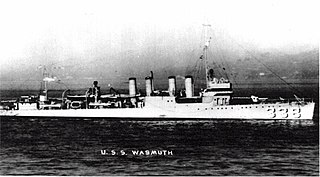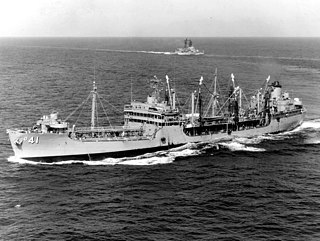
USS Sapelo (AO-11) was a Patoka-class fleet replenishment oiler of the United States Navy. Laid down on 3 May 1919 for the United States Shipping Board by the Newport News Shipbuilding and Dry Dock Co., Newport News, Virginia, the ship was launched on 24 December 1919, transferred to the Navy on 30 January 1920, and commissioned on 19 February 1920.

USS Guadalupe (AO-32), a Cimarron-class fleet replenishment oiler that served in the United States Navy, it was named for the Guadalupe River in Texas.

USS Rapidan (AO-18), was a US Navy tanker of World War II.

USS Salinas (AO-19), a United States Navy Patoka-class replenishment oiler, was laid down for the United States Shipping Board (USSB) as Hudsonian (219592) on 10 April 1919 by the Newport News Shipbuilding and Dry Dock Co., Newport News, Virginia; launched on 5 May 1920; accepted by the USSB on 13 May 1920; transferred to the Navy on 29 October 1921; renamed Salinas and designated AO-19 on 3 November 1921; and commissioned at Mobile, Ala., on 16 December 1921.

Fleetco, a Patoka Replenishment oiler built by the Newport News Shipbuilding and Dry Dock Co., Newport News, Virginia, for the United States Shipping Board, was launched on 21 April 1920; transferred to the Navy by Executive Order on 17 October 1921; renamed USS Sepulga (AO-20) on 2 November 1921; delivered to the Navy at Mare Island, California, on 13 December 1921.

USS Tippecanoe (AO-21) was a Patoka Replenishment oiler of the United States Navy.

USS Wasmuth (DD-338/DMS-15) was a Clemson-class destroyer in the United States Navy following World War I.

USS Platte (AO-24) was a Cimarron-class oiler serving with the United States Navy, named for the 1836 Platte Purchase that included the Platte Rivers in Iowa, Missouri and Nebraska. Her memorial in Platte County, Missouri honors all four rivers that share the name recorded by Lewis and Clark in 1803.

USS Kaskaskia (AO-27) was a Cimarron-class fleet replenishment oiler serving in the United States Navy, named for the Kaskaskia River in Illinois.

USS Neosho (AO–48) was a Kennebec-class type T2 fleet oiler of the United States Navy. The ship was laid down on 8 July 1941, as SS Catawba, by the Bethlehem-Sparrows Point Shipyard Inc., Sparrows Point, Maryland. The purchase came under Maritime Commission contract number 145 for the Socony-Vacuum Oil Company, later renamed Mobil Oil.

USS Kankakee (AO-39) was a Kennebec-class fleet oiler of the United States Navy. The ship was built as SS Colina by Bethlehem Steel Co., Sparrows Point, Maryland, launched on 24 January 1942, sponsored by Mrs. D. A. Little, acquired for the Navy on 31 March through the Maritime Commission from her owner, Socony-Vacuum Oil Company, New York City, and commissioned as Kankakee at Norfolk, Virginia, on 4 May.

USS Mattaponi (AO-41) was a Kennebec-class oiler which served in the United States Navy during World War II, periodically during the 1950s, and in the Vietnam War. She was the only U.S. Navy ship named for the Mattaponi River in eastern Virginia.
USS Cache (AO-67) was a Type T2-SE-A1 Suamico-class fleet oiler of the United States Navy.

USS Saugatuck (AO-75) was a Suamico-class replenishment oiler of the United States Navy.

USS Millicoma (AO-73) was a United States Navy fleet oiler which served in the Pacific Theatre during World War II, winning eight battle stars for her dangerous work. Post-war she was recommissioned and was placed under the control of the MSTS with a civilian crew until finally assigned for disposal in 1987.

USS Schuylkill (AO-76), originally named the SS Louisburg, was a Type T2-SE-A1 Suamico-class fleet oiler of the United States Navy.

USS Neshanic (AO-71) is a former T3 Kennebec-class oiler constructed for the United States Navy during World War II. She was the only U.S. Navy ship named for the Neshanic River in New Jersey.

USS Kern (AOG-2) was a Patapsco-class gasoline tanker acquired by the United States Navy for the dangerous task of transporting gasoline to warships in the fleet, and to remote Navy stations.
USS Pasquotank (AOG-18) was a Mettawee-class T1 tanker type gasoline tanker acquired by the U.S. Navy for the dangerous task of transporting gasoline to warships in the fleet, and to remote Navy stations.

USS Chewaucan (AOG-50) was a Patapsco-class gasoline tanker in service with the United States Navy from 1945 to 1975. She was then transferred to the Colombian Navy, her final disposition being unknown.


















